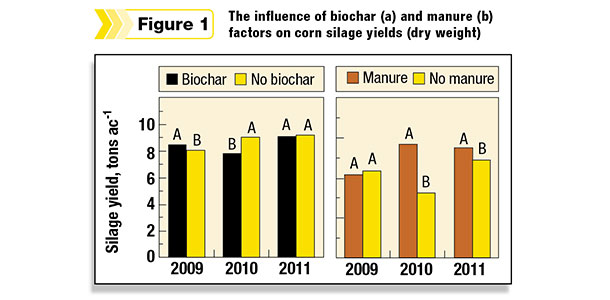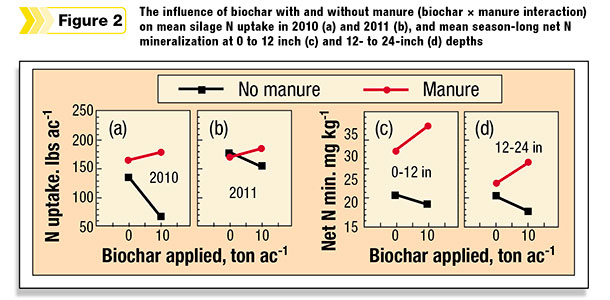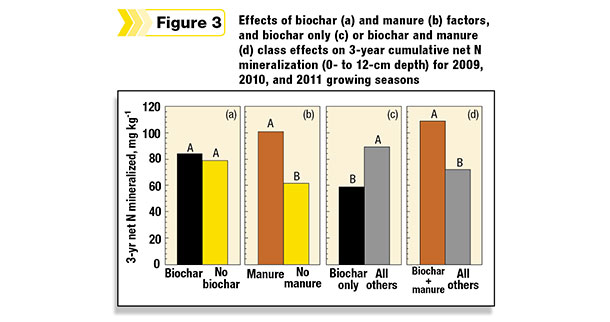Biochar is charcoal or black carbon produced from the incomplete burning of organic material under reduced oxygen conditions, i.e., pyrolysis.
When vegetation, a photosynthetically fixed carbon (C) biomass, is pyrolyzed, it produces gases, liquids (bio-oil; an energy source) and a solid (biochar).
Biochar is generating a great deal of interest for three reasons: First, the C comes from CO2, a greenhouse gas that is extracted from the atmosphere by growing plants; second, biochar added to leached, tropical soils dramatically increased their productivity (e.g., Terra Preta soils of South America); and third, biochar persists for a long time (more than 100, perhaps more than 1,000 years).
Thus, we can potentially decrease atmospheric CO2 and mitigate climate change by adding biochar to soils, where it may provide persistent crop production benefits.
However, while biochar effects on highly weathered soils of the humid tropics and acidic forest soils has been studied, its effects on irrigated, calcareous soils, like those in the U.S. Intermountain West, are less understood.
A three-year field study was conducted in southern Idaho to evaluate the effect of hardwood biochar and dairy manure, along with their combined effects on net-N mineralization and greenhouse gas emissions. The study treatments consisted of a one-time fall application of an organic amendment followed by three years of sprinkler-irrigated silage corn.
The four treatments included:
- Control (no organic amendment)
- Manure (18.7 ton ac dry weight)
- Biochar (10 ton ac dry weight)
- Manure + biochar (at single-treatment rates)
The biochar was made from oak and hickory hardwood sawdust by Dynamotive Energy Systems (Ontario, Canada), contained 66 percent C and 14 percent ash, and had a near-neutral pH. Annual inorganic N fertilizer rates were adjusted for N mineralized from manure each growing season, such that initial available N was similar in all plots.
We measured net N mineralization using buried soil bags (where the net value represents the gross mineralized N minus gross immobilized N), soil greenhouse gas (CO2, CH4, and N2O) emissions from late spring to fall, corn silage yields and crop N uptake each year.
Corn silage yields and N uptake

Treatment effects on corn silage yields and silage N concentrations are shown in Figure 1. Overall, corn silage yields averaged 8.6 tons ac (dry weight) across the three years. The influence of biochar and manure on silage yield changed with time after application in fall 2008.
Biochar increased corn yields slightly (5 percent) in 2009, decreased yields by 14 percent in 2010 and had no effect in 2011. Conversely, manure had no effect on yields in 2009 but increased yields substantially in 2010 (33 percent) and again slightly in 2011 (7 percent). In 2010, the effect of biochar and manure on silage N uptake followed the same pattern as that for yield, suggesting that treatment yield effects resulted from changes in N availability.

Also intriguing was the fact that biochar’s influence dramatically changed when combined with manure, i.e., a biochar × manure interaction was observed. (An example of this is shown in Figure 2).
In 2010 and 2011, biochar reduced silage N uptake without manure but increased N uptake when combined with manure. Was this occurrence the result of biochar and manure effects on N mineralization?

The three-year, cumulative, net N-mineralization data in Figure 3 show that biochar had no effect on net N mineralized over the long term and thus did not provide a source of readily mineralizable organic matter to soil micro-organisms.
On the other hand, manure substantially increased cumulative net N mineralization (Figure 3b), confirming it as a ready source of mineralizable organic matter.
However, when the biochar was added alone, it reduced three-year net N mineralization (33 percent less) relative to the other three treatments together (Figure 3c); whereas, when added with manure, the combined biochar + manure treatment maximized three-year net N mineralization (1.5-fold greater) compared to the other treatments (Figure 3d).
These results are due to a biochar-manure interaction, which occurred with net N mineralization at both zero to 12 inches and 12-inch to 24-inch soil depths (Figure 2).
When added alone, biochar slightly reduced mean net N mineralization at both depths, but when added with manure, biochar increased net N mineralization. This suggests that biochar either reduced gross N mineralization or decreased the ratio of gross N mineralization to gross N immobilization.
Biochar minimized both CO2 and N2O gas emissions compared to all the other treatments as a class (P less than 0.01). This suggests that N immobilization decreased because CO2 emissions from soil are strongly correlated with immobilization.
Consequently, gross N mineralization must have also declined. The evidence suggests that biochar either inhibited soil microbial activity, altered microbial community composition or changed the partitioning of N through proteolysis (protein breakdown), ammonification or nitrification pathways, and subsequently reduced N assimilation by microbes. The overall effect of these changes would result in the apparent stabilization of soil C.
Why did biochar reduce silage yields only in 2010?
Results suggest that biochar reduced 2010 yields by decreasing N availability. Biochar’s positive yield effects in 2009 imply that the aging of applied biochar may have altered its characteristics.
It is known that soil aging increases the number of negative-charged sites on biochar, which increases its capacity to bind and act as a sink for NH4-N. Also, because the yield depression occurred only in one year out of three, it may have resulted from particular circumstances peculiar to the 2010 season.
The 2010 season was unique for these reasons:
1. Crop residue in 2009 was derived from the previous barley crop, which has a relatively high C-to-N ratio, while the crop residue in 2010 was from corn, with a relatively low C-to-N ratio.
2. Soil temperatures in 2010 were substantially less than those of other years.
These two factors combined to inhibit nitrification in soils, which caused an increase in soil NH4-N concentrations relative to NO3-N in late-summer 2010 compared to earlier times.
We hypothesize that this predominance of NH4-N in soil, combined with biochar’s increased capacity to sequester NH4-N in 2010, led to a shortage of available inorganic N for crop uptake.
While the biochar-only treatment demonstrated a potential to minimize CO2-C and N2O-N gas emissions in these calcareous soils, biochar also caused decreased corn yields under certain soil nutrient conditions.
If farmers wish to apply biochar to these soils, combining it with manure appears to be an effective method of utilizing these soil amendments, as it eliminated potential yield reductions from biochar and maximized net N mineralization potential of the added manure. FG
Jim Ippolito and Kurt Spokas are with Soil and Water Management Unit, USDA-ARS.
References omitted due to space but are available upon request. Click here to email an editor.
Rick Lentz
Northwest Irrigation and Soils Research Laboratory
USDA-ARS











